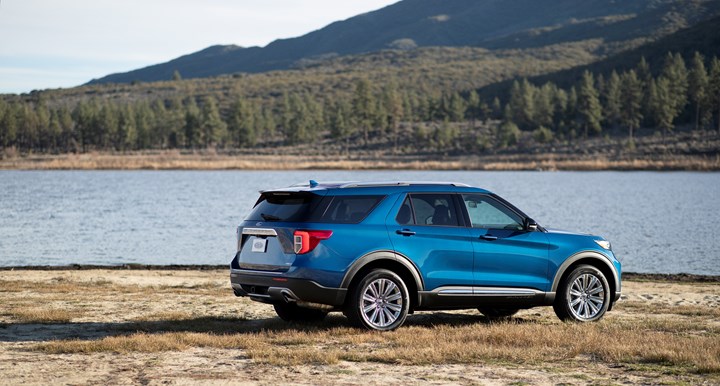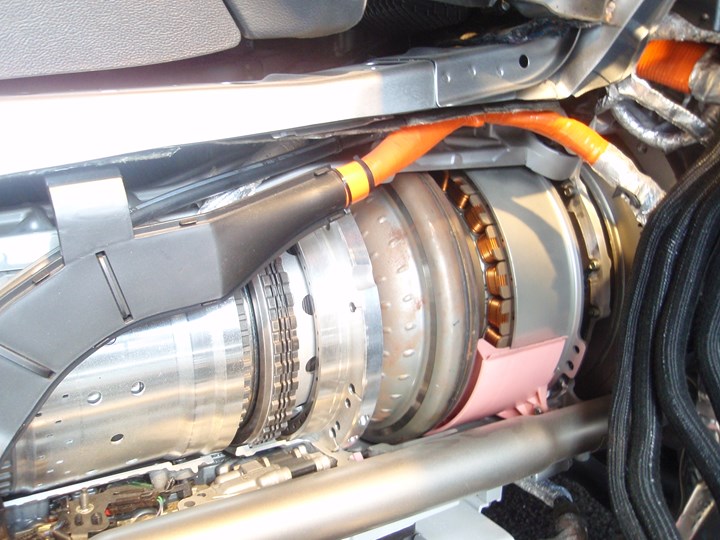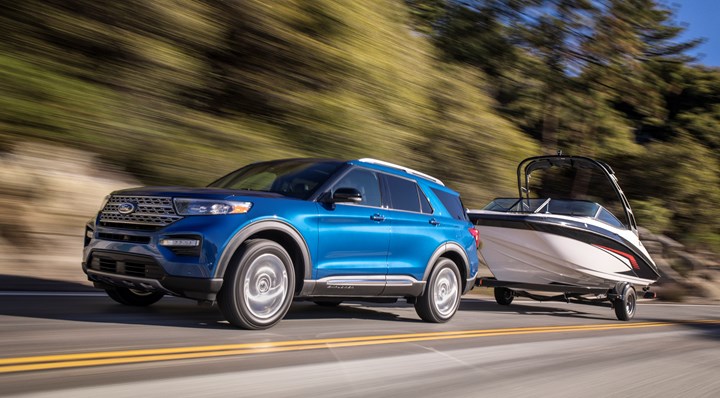Exploring the 2020 Ford Explorer Hybrid
When the all-new 2020 Ford Explorer was being developed, the decision was made to provide a hybrid version of the midsize utility. Given the demands of customers for what a vehicle like the Explorer is supposed to do, Ford engineers worked to develop a new hybrid system. Here’s a look.
#electronics #hybrid #interior
The word compromise has a few meanings. As a noun it is about making concessions to achieve something. As a verb it is about accepting standards that are less than ideal.
And when Gitanjli McRoy, Hybrid Powertrain Systems Manager at Ford, talks about the development of the hybrid system for the 2020 Explorer, she is very insistent: “This is a no compromise vehicle.”

The 2020 Explorer Hybrid is the first of what will be several Ford vehicles to have a new hybrid architecture.
An important point about the 2020 Explorer is that it is an all-new rear-drive architecture. There were many groups involved in the development of the overall platform, which is available with different engines (a 2.3-liter EcoBoost I-4 and a 3.0-liter EcoBoost V6) in addition to the powertrain used for the Hybrid. And her “no-compromise” is echoed by other members of the Explorer development team. While there are some hybrid vehicles that start as vehicles meant to simply have internal combustion engines and then have the addition of the e-motor arrangement, McRoy says that there was consideration of having a hybrid powertrain for the Explorer at the very start. This, too, helps achieve the no-compromise approach.
Under the Hood
The Hybrid makes use of an aluminum 3.3-liter naturally aspirated V6 engine that’s produced in the Ford Lima Engine Plant and an e-motor that produces 44 hp; all in, the system output (i.e., engine and e-motor) is 318 hp and 322 lb-ft of torque. There is also a 10-speed transmission that is produced at the Livonia Transmission Plant.
Andy Kummer manager, Hybrid Transmissions, Transmission & Driveline Engineering, explains that this 10-speed is very close to the transmissions that are used in the other, non-hybrid versions of the Explorer (Base, XLT, Limited, ST, and Platinum). How close? “There is about 90 percent parts commonality between our hybrid transmission and the other 10-speed.”
Kummer notes that there is flexible production of the transmissions in the plant such that the right mix of them can be produced to meet consumer demand. To assure this flexibility, the lug points on the transmission cases are the same so that there is common location for the production equipment.
The e-motor is connected to the front of the torque converter. This configuration is known is a “P2 hybrid” (as in generically, not just within the Ford nomenclature).

The e-motor is attached to the front of the torque converter on this 10-speed step-gear transmission.
“We have four different drive modes,” he says. “We’re able to drive engine-only, electric motor only, or we’re able to drive engine plus electric motor and get a boost in horsepower and torque. And the fourth one is regenerative energy recovery: taking the kinetic energy of the vehicle as it slows, braking, recapturing that, using the motor as a generator, feeding it back to the battery.”
Kummer says that the 10-speed for the Hybrid is 160 mm longer and about 43 kg heavier than the 10-speed used in the other Explorer variants, with both changes being driven by the addition of the e-motor, with the weight being not only for the motor itself, but also for the additional length of the transmission case. What’s more, there is more transmission fluid required, which creates what he calls a “wet environment.”
“Having a wet environment is an advantage for us,” Kummer says, as it helps reduce the drag loss of rotating components.”
Like all 2020 Explorers, the drivetrain layout is standard rear-wheel drive. All-wheel drive with front axle disconnect (when the front wheels don’t need to be powered this setup allows the disconnection for purposes of improved fuel efficiency) is available, too.
“We use the standard mechanical systems for all-wheel drive; we don’t add any electric motors,” McRoy says. It is essentially the same architecture used for the non-hybrid versions. Which is, again, one of the advantages of developing the vehicle with all parties involved at the start.
Why It Can Tow
A feature that is important for all Explorers in the context of providing the capabilities that consumers like to have, something that there would be no compromise on for the development of the hybrid system, is the ability to tow.
“One of the reasons we kept the torque converter in this architecture,” says Kummer, “is because it is a critical element for towing—both for the torque multiplication and for the damping.”
The Hybrid has the capability of towing up to 5,000 pounds.

The Explorer Hybrid has a towing capacity of up to 5,000 pounds.
A word about the setup of the hybrid system for the Explorer (and it will be making its way to the F-150, as well) as compared to the hybrid system for the Fusion Hybrid is that the former is engineered to be more robust and capable, as in this towing capability, thanks in large part to the use of the electric motor being integrated with the step-gear transmission. In the case of the Fusion Hybrid (as well as for what is probably the most well-known hybrid on the planet, the Toyota Prius), there is an integration of an electric motor with a continuously variable transmission (eCVT). Ford calls its system “PowerSplit.” McRoy explains that given the weight of the Explorer and the use cases (as in towing), “We asked ourselves what the right electrification architecture for the vehicle would be.” And the answer was the P2. That said, Kummer notes that the eCVT architecture used for applications like the Fusion will remain in the Ford powertrain suite for applications in cars and crossovers, with a PowerSplit system being used in the 2020 Escape Hybrid.
Energy Efficiency
Another strategy taken by the team in developing the hybrid system was to be, as McRoy puts it, “opportunistic.” For example, they upgraded the braking system so that the regenerative braking can be optimized. When the vehicle is coasting or the brake pedal is being applied, then the system will start with regen (i.e., using the e-motor resistance as a back drive, which reduces the speed of the vehicle and as the motor is acting as a generator, it puts energy into the battery), then fold in the friction brakes as required.
When the vehicle is idling (this is of particular importance for the Police Interceptor version of the vehicle, as some 60% of the time one of those could be idling), there is what McRoy calls “smart idling.” Jeff Bobak, Hybrid Powertrain Calibration manager, explains, “We’ll fun the engine in a very efficient spot to make sure that when there is need for charging it will use the least amount of fuel possible to give power to the battery.” For example, the system can determine if the electric air conditioning system (no belt on the engine) and if the lights and flashers are on. “We know the exact state of charge,” Bobak says. So the objective is to tailor the amount of fuel burned by the engine so as to meet the demand requirements.
Returning to the topic of “no compromise,” one of the things that McRoy emphasizes about the packaging of the hybrid system is that it doesn’t have any effect on the interior volume, whether for passenger or for cargo, is the same. That is, for the passenger volume it is 152.7-ft3 (with the exception of the Platinum model, which is 146.8-ft3 because it comes with a standard moonroof, which takes up some of that interior space) and the cargo volume behind the first row is 87.8-ft3 across the entire lineup.
Know that there is a liquid-cooled 35-kW lithium-ion battery as part of the Hybrid powertrain system that the others don’t have, again because the Hybrid version was taken into account at the start of the development program, measures were taken to assure that the battery could be accommodated in the chassis, below the second-row seats, with no compromise for the interior space.
So like the other vehicles in the 2020 Explorer lineup, there is room for people and cargo. There is performance in the form of a system output of 318 hp (and as McRoy points out, “The e-motor has high torque from the start, so it gives a nice fill when accelerating”). There is the choice of rear- or all-wheel drive setups. There is an array of features, including Ford Co-Pilot360 Assist+ (a suite of driver-assist technologies ranging from pre-collision assist with automatic emergency braking to a rearview camera with a built-in lens cleaner), second-row heated seats, and a 14-speaker B&O premium audio system.
No compromise. But the fuel efficiency of a hybrid.
RELATED CONTENT
-
Lincoln Corsair Takes Flight
“We wanted to create a dramatic, youthful Lincoln with terrific harmony.” And with the Corsair, they’ve accomplished what they set out to do.
-
2018 Ford EcoSport: Small Is the New Big
Eric Loeffler, chief program engineer for the 2018 Ford EcoSport, recalls driving home from work one day from the product development center in Brazil where work was underway on developing the vehicle that will be coming to the U.S. in 2018, having been launched in 2003 in South America and is now become available in 140 countries around the world.
-
On the 2016 Chevrolet Camaro: The Sixth Generation
The fifth-generation Camaro brought the nameplate back from what could have been oblivion. The sixth is taking it in the right direction.


.jpg;width=70;height=70;mode=crop)